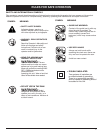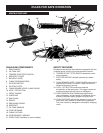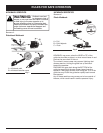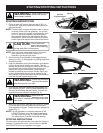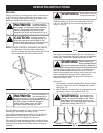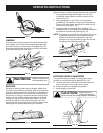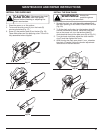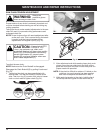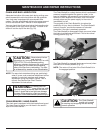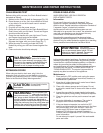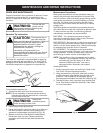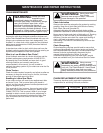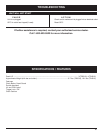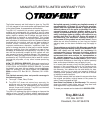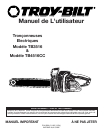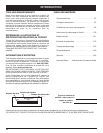
15
CHAIN AND BAR LUBRICATION
Adequate lubrication of the saw chain during cutting oper-
ations is essential to minimize friction with the guide bar.
Your chain saw is equipped with an automatic oiler
system. The oiler automatically delivers the proper amount
of oil to the bar and chain. There is no flow adjustment.
You can check the oil tank level using the inspection slot
(D) provided on the right side of the saw. The tank is full
when oil is at the top of the slot (Fig. 25).
CHAIN BRAKE® / HAND GUARD
This chain saw is equipped with chain brake/hand guard.
The Hand Guard protects your left hand in the event it
slips off the front handle.
Never starve the bar
and chain of
lubrication oil. Running the saw DRY or with
TOO LITTLE OIL will decrease cutting
efficiency, shorten chain saw life, and cause
rapid dulling of the chain and excessive
wear of the bar from overheating. Too little
is evidenced by smoke or bar discoloration.
CAUTION:
A loose chain can
jump off the bar while
you are cutting, as well as wear the bar and
chain. A chain that is too tight can damage
the saw. Either situation, chain too loose or
too tight, could cause serious personal injury.
WARNING:
The Chain Brake®
should not be used
for starting and stopping the saw during
normal operation
CAUTION:
MAINTENANCE AND REPAIR INSTRUCTIONS
D
Fig. 25
Fig. 27
The Chain Brake® is a safety feature which is activated if
pressure is applied against the guard or when, in the
event of kickback, the operator’s hand strikes the lever.
When the Chain Brake® is activated, chain movement
abruptly stops and the power supply to the motor is
immediately cut off.
The purpose of the Chain Brake® is to reduce the
possibility of injury due to kickback. The Chain Brake®
cannot, however, provide the measure of intended
protection if the saw is carelessly operated.
The Chain Brake® is disengaged (chain can move) when
the brake is pulled back and locked. This is the normal
running position (Fig. 26).
NOTE: The saw chain stretches during use, particularly
when it is new, and occasional adjustment will be
needed. A new chain requires more frequent
adjustment during the break-in period. This is
normal. See Section Saw Chain Tension
Adjustment for instructions.
Fig. 26
The Chain Brake® is engaged (chain cannot move) when
the brake is in forward position (Fig. 27).
NOTE: The motor will not start if the Chain Brake® is in
the engaged position.



